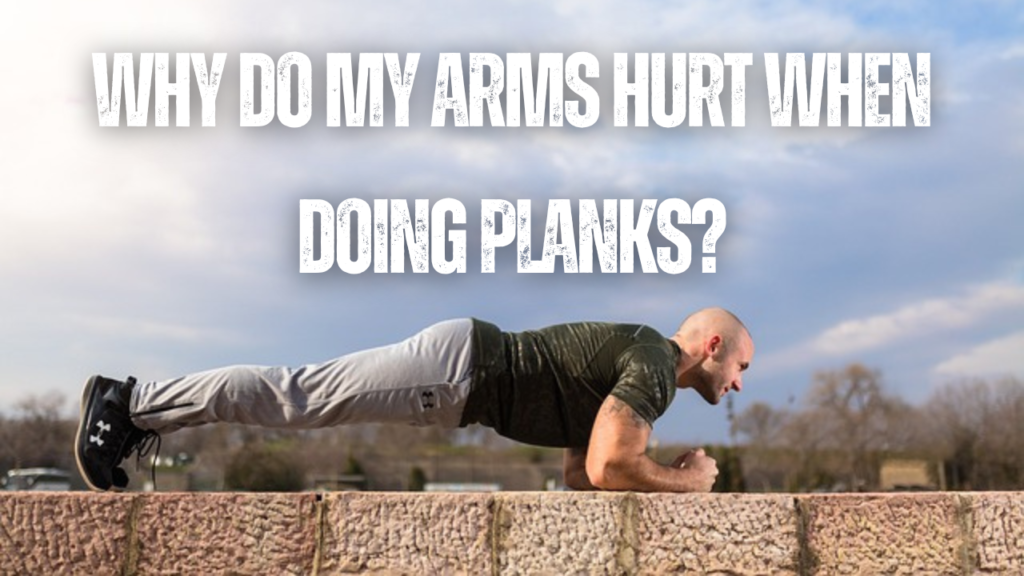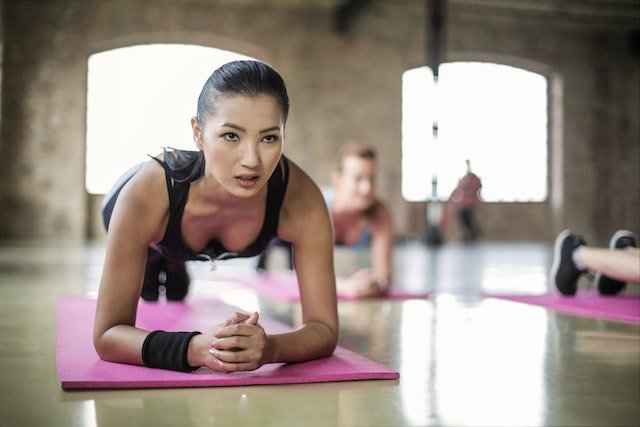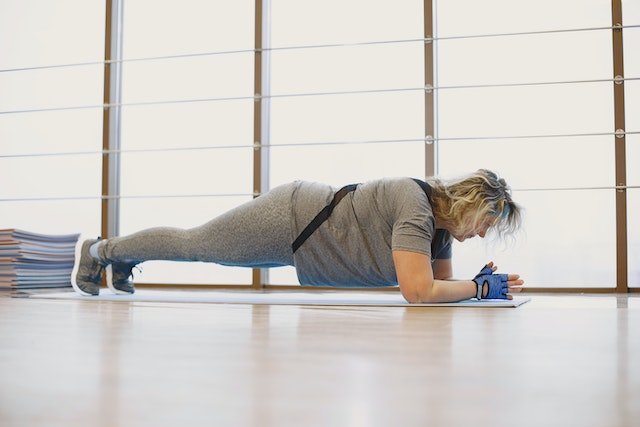
Why Do My Arms Hurt When Doing Planks? Find Out Here
Do you find yourself wondering why your arms are so sore after doing a plank? You’re not alone!
Planks are one of the best exercises to strengthen your core and overall body, but they can also cause uncomfortable arm pain. In this article, we’ll explore the key reasons why planks may be causing arm pain and provide some simple tips for avoiding discomfort during planking.
Read on to learn more about how to avoid pesky arm pains while utilizing the full benefit of this challenging yet rewarding exercise!
Why do my arms hurt when doing planks?
The plank is a pretty simple exercise in principle where you hold your body in a straight line while balancing on your hands and toes. It’s a great full-body exercise, but the pressure of having your arms support all of your weight can cause pain if you’re not careful. The main reasons why planks can cause arm pain is from having them too wide or narrow in relation to your body, having arms placed too high or low for the same reason, clenching the fists unintentionally, or how your forearms are positioned. In addition to these factors, muscular tension from the exercise, lack of cushioning which can affect how comfortable the exercise feels, weak muscles and imbalances, as well as a lack of core strength and how much you weigh can also contribute to arm pain while planking. Volume and range of motion (ROM) are also important considerations, as doing too many planks or having a limited ROM can lead to arm pain. If you’re new to planking, it may be wise to start with an easier version like the modified plank off your knees. To understand how to resolve your pain, you must determine if it is muscular or bone-related. If so, the treatments vary and should be selected accordingly.
While planks may appear to be an uncomplicated exercise, they can still lead to pain in the arms. To help you understand why this happens and how it can be remedied, let’s take a close look at what might be causing your discomfort…
Muscular or bone-related pain
When you experience arm pain from doing planks, first and foremost you need to determine what type of pain you are feeling.
If it’s muscular it will feel like a tightness or burning sensation in the muscle. To fix this you can try foam rolling, massaging the affected area, stretching, and/or using heat or cold packs to reduce inflammation.
If it’s bone-related it will be more of an uncomfortable ache, which could indicate an underlying injury. If this is the case then you should get checked out by a doctor to make sure there is no damage.
If you have recently recovered from an injury then you should pay particular attention to your form when doing planks and make sure it’s fully healed before going back to doing them.
To help prevent arm pain while planking, you should adjust your body position in relation to the plank exercise. Make sure that your arms are not too wide or too narrow in comparison with your body and that they are placed at the right height for the exercise.
Arm placement
One of the most common causes of arm pain while planking is having your arms too wide or narrow in relation to your body. When arms are too wide, they can shift a lot of pressure towards outside wrists and elbows, leading to discomfort.
On the other hand, when your arms are too narrow, it shifts more pressure on the inner side of the arms and shoulders, which can also cause pain. You want to make sure that you keep your arms at a comfortable distance from your body, which is usually just outside of shoulder width apart.
Similarly, when your arms are placed too high or low in relation to the body, it leads to a lot of strain on the wrists, elbows and upper arms. To prevent discomfort from arm placement when planking, make sure that your forearms are parallel to the ground and that your elbows are directly below the shoulders.
If you are new to fitness and exercise it might take you a few sessions to find a comfortable plank position which works best for you.
I also understand we all have varying ranges of motion, so adjust your arm placement accordingly to what is comfortable for you.
Clenching fists and tension
Another common issue is clenching your fists when planking, which can lead to a lot of tension in the arms. To ensure that you’re not unintentionally clenching your fists, be sure to keep them relaxed and open throughout the exercise. You can also try pressing your palms into the floor for extra stability.
If you clench your fists for too long, it will lead to fatigue and discomfort in the arms so take regular breaks to relieve the tension.
When we do something challenging like moving a heavy weight or doing a plank, it’s natural to want to tense up and hold on tight. However, it’s important to stay relaxed while planking in order to reduce tension in the arms and maximize the benefits of this exercise.
Try to refocus your attention on keeping a solid core and glutes, while relaxing your hands as this will help support your arms and reduce pressure.
Obviously, there needs to be a certain amount of tension when doing planks, however, it should be controlled and calculated. Aim for a balance between tension and relaxation, so you achieve the perfect plank position with minimal arm discomfort.
Proper breathing is key when it comes to physical activity and body tension. To ensure that your muscles remain relaxed while planking, make sure you deeply inhale and exhale…this will ultimately decrease arm fatigue as well as prevent hyperventilation from holding the breath too long.

Forearm position
The position of your forearms is another important factor to consider as it affects how much pressure is put on the arms and wrists. You should aim to keep your arms in a neutral position with the palms facing down and fingers pointing forward throughout the exercise.
The best way to think of this would be like the sphinx pose in yoga, where your forearms are parallel to one another and the hands are directly below the shoulders. This will help evenly distribute weight across your arms and prevent strain.
This will help distribute your body weight evenly and prevent any strain from accumulating in the wrists, elbows or shoulders.
If you feel like you need extra support for your forearms, a pair of wrist wraps can be extremely helpful. Not only do they provide additional stability but they can also reduce pressure on the wrists and arms while planking.
Your body weight
Body weight is a factor that’s often overlooked but can still contribute to arm pain when planking. If you weigh too much for your frame size, it will cause more pressure on the arms and shoulders which can lead to discomfort.
You don’t have to be skinny or fit in order to do planks, but it’s important to keep your body weight in check. Eating a healthy, balanced diet and doing regular exercise can be beneficial in terms of keeping your weight proportional to the frame size.
You might be overweight and that’s exactly the reason you are doing planks, to lose weight and get fit.
All I’m saying is that, if you are carrying a little weight, added to the fact you could be new to fitness might cause your arms to hurt while planking, until you and your arms are accustomed to them.
If you have difficulty maintaining balance while planking due to excessive weight, try using a stability ball or some other support device which will help take some of the load off your arms.
Start off slowly with a lightweight version of the exercise and gradually increase the intensity until you can comfortably hold the full plank position.
Related: Why are my abs gone right after ab workout?
Body alignment
It’s essential to ensure that your body is properly aligned when planking in order to prevent any strain from accumulating in the arms.
The main points of focus should be the core, back and glutes as these are what will provide most of the support for your arms during this exercise.
Make sure you keep your head and neck in a neutral position, your spine straight and your glutes engaged in order to get the most out of the exercise while avoiding arm pain.
If you have trouble maintaining proper alignment or feel any discomfort during the exercise, make adjustments as needed or break it down into smaller sets with rests in between.
Range of motion
If for any reason you have a reduced range of motion (ROM) in the shoulders and arms, this can cause pain while planking.
Stretching exercises like shoulder rolls and arm circles will help to increase flexibility in your joints.
To some, the plank position might be a very uncomfortable one due to having a limited range of motion in these areas.
Take your time and if needed, try using different plank variations such as the knee-elbow plank or side plank which can help reduce any pressure on the arms and shoulders.
I personally tend to find that planks feel more comfortable with the outside of my forearms and hands on the floor (see image below), with my pinkies being the only fingers touching the ground.
The sphinx pose (as mentioned earlier) requires more range of motion than my body is comfortable with for longer periods of time. Therefore, executing the exercise with my palms and forearms flat on the ground can be quite uncomfortable and awkward for me.
If you still experience pain after trying out different positions, it is best to consult a doctor or physical therapist to best assess the situation.

Cushioning
Another way to reduce arm pain when planking is with the use of a cushion or pad under your arms. This will provide more support for your arms and help distribute weight evenly, so you can maintain proper form without putting too much strain on them.
A yoga mat is an excellent choice if you’re looking for something that’s both comfortable and provides enough cushioning for your arms.
The only thing with a yoga mat is that the standard thickness is 5mm, for some this won’t be enough. So you could double up the yoga mat by folding it in half or use a thicker cushioning for more support.
However, you don’t want too much cushioning as this might make the exercise difficult to do because you won’t be able to balance correctly.
Find something around 10-15mm thick and experiment with it until you find a comfortable thickness that allows you to plank without pain.
Not warming up
One mistake I see with planking is not warming up properly. Warm muscles are more flexible so it’s important to start off with some dynamic stretches and light exercises prior to doing planks.
This will help increase blood flow and decrease the risk of any potential injuries while engaging in this exercise.
If you are doing planks right out the gate, your asking a lot of your body to be able to handle the weight and strain that comes with it.
Take your time when warming up, focus on the right areas such as arms, legs, back and core. Doing this will help reduce any pains or aches you may experience during planking.
Don’t forget to cool down after your workout too, this will help reduce any soreness or pains you may experience after your workout.
Related: Why can I only see my upper abs?
Weak muscles and imbalances
When planking, your body and arms will be forced to take on the weight of your entire body.
If you are new to fitness or you suffer from weak muscles in certain areas, this can cause an imbalance and make it difficult for you to maintain proper form while planking.
The best way to address this is by focusing on strengthening the affected muscles and doing exercises that target them.
If your arms are weaker, they will feel the strain more than other parts of the body, so it’s important to focus on strengthening them.
Push-ups and tricep extensions are great exercises for building arm strength and improving overall balance.
Once your arms are stronger, you shouldn’t experience as much pain when planking.
This will help you build a balanced physique, improve your overall strength and reduce any discomfort in your arms while planking.
Weaker muscles and imbalances are common issues that can many people with sedentary lifestyles and those who don’t have a consistent workout routine.
So take your time in strengthening these muscles and stay dedicated to your fitness goals, and you will be able to perform planks without any pain or discomfort.
Volume overload
Another factor to consider when it comes to arm pain while planking is the volume of your workouts.
If you are doing too much too soon, this can cause a lot of strain on the muscles and lead to fatigue, pain or even injury.
When performing planks, start off with shorter sets, focus on proper form and add more sets as your strength increases.
It’s also important to take breaks in between each set so you can let the muscles rest and recover.
If you feel any pain or discomfort, stop immediately and revisit your plank routine to make sure it’s appropriate for your current level of fitness.
Don’t be intimidated by other people’s high-intensity training routines…exercise according to your own ability. Start small and set attainable objectives that will help you work towards bigger goals step by step.
With steady progress, you’ll reach the fitness level of those who can plank for extended periods soon enough!
Stop doing them
Finally, if you can’t seem to get on with planks and you experience discomfort in your arms or any other body part, then it may be best to stop doing them for a while.
Try doing some alternative exercises that don’t cause you any pain and focus on strengthening the muscles responsible for them.
Once these muscles have been strengthened, you can then reintroduce planks back into your routine with proper form and technique.
It is important to listen to your body and if it is telling you that planks are not something you should be doing, then don’t do them.
There are other forms of exercise like yoga or Pilates that can help you achieve the same goal without putting pressure on the arms.
So be mindful of your limitations and find an exercise routine that works best for you.
Related: Why do lying leg raises hurt my legs more than my abs?
Final thoughts…
The plank is a great exercise for strengthening the core, arms and other muscles of the body.
However, it is important to make sure that your form is correct and you have the necessary strength in order to prevent any pain or discomfort.
If you experience arm pain while planking, take into consideration the factors mentioned above and make the necessary adjustments to your routine.
Although planks may be challenging, there is no reason why you can’t enjoy them and reap all the benefits they have to offer!
Have your arms hurt when doing planks and have these tips helped? Let us know in the comments below.


